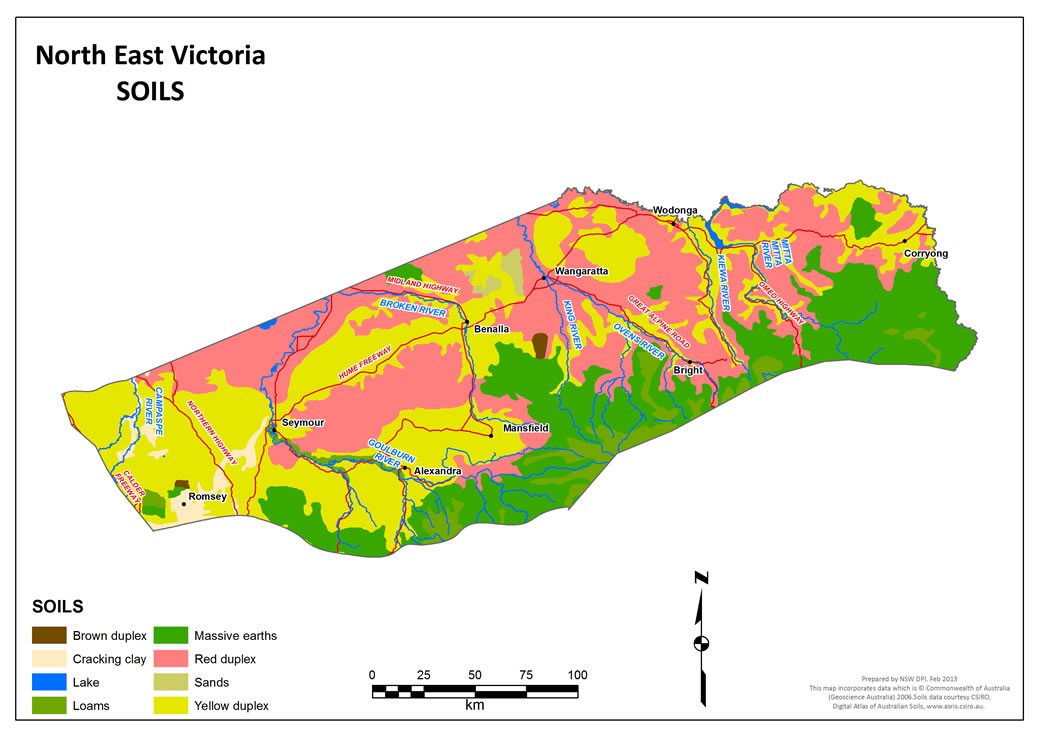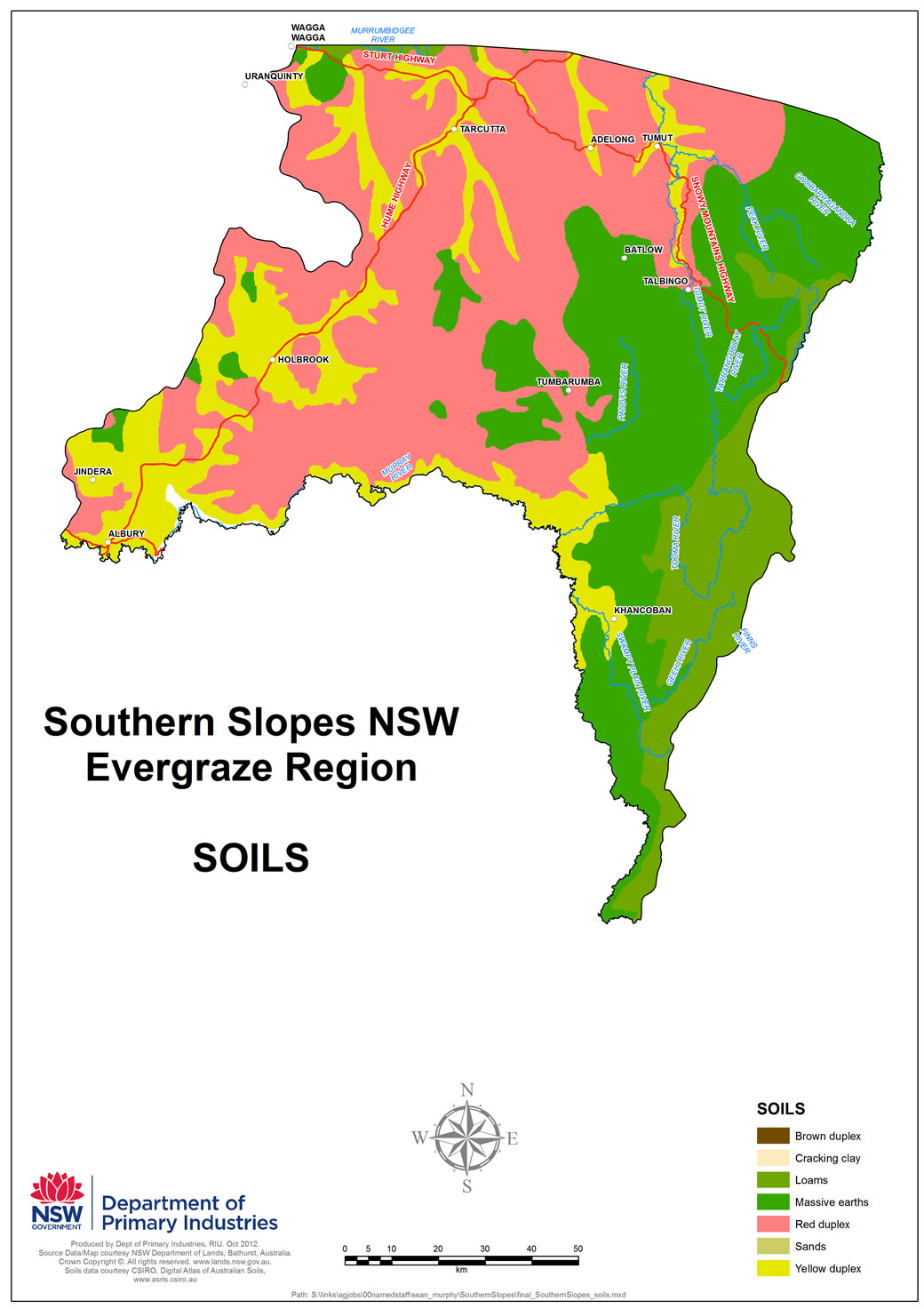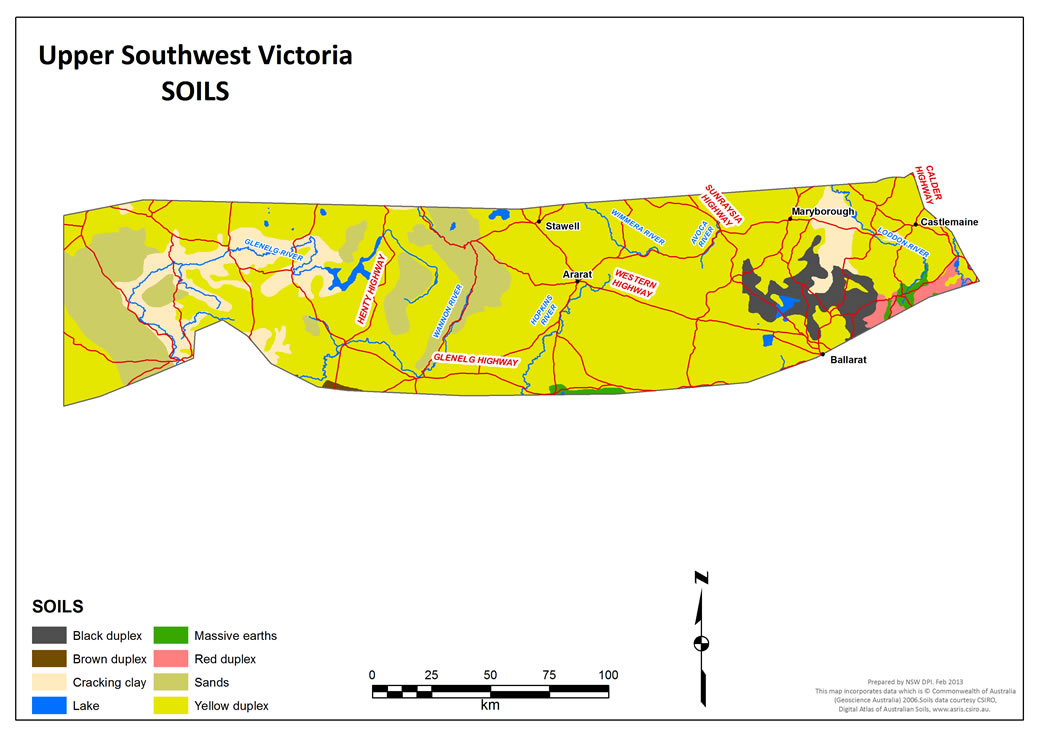North East Victoria, Southern Slopes NSW, South West Victoria (Upper) – Soils
Description
Soils of this region consist of a diverse range of soil types which reflects the variation in parent material, topography, climate, age and organic activity. The orders within the Australian Soil Classification system are represented throughout the three regions of North East Victoria (Figure 1), Southern Slopes of NSW (Figure 2) and South West Victoria – Upper (Figure 3) with texture contrast soils (Chromosols, Sodosols and Kursols) dominating the landscape.
Chromosols and Kurosols consist of sandy loam to loam topsoil over a clay subsoil. Kurosols have a strongly acidic subsoil (pH < 5.0 CaCl2) and are located in the uplands where rainfall and elevation is higher. Chromosols are prominent in North East Victoria and Southern Slopes of NSW and are distinguished by a subsoil pH greater than 5.0 CaCa2.
Sodosols consist of clay loam topsoil over medium to heavy clay subsoil which is sodic (ESP > 6%) and are generally found on the plains and slopes. These soils can also display a bleached layer between the topsoil and subsoil indicating restricted drainage, lower nutrient retention and reduced soil strength.

Click here to see the same map with the Australian Soils Classification system.
Dermosols dominate the higher rainfall regions of North East Victoria whereas Chromosols and Kurosols dominate the Southern Slopes of NSW. A small area of Ferrosols at Dookie and near Ballarat consist of very permeable clayey soils with high content in free iron oxide (> 5%). These soils that lack texture contrast pose fewer physical limitation to plant growth.

Vertosols at Maryborough, Romsey and Casterton comprise of clay soils with shrink-swell properties. These soils are relatively fertile however can be imperfectly drained when wet.
Podosols found west of Casterton have very light (sand to loamy sand) topsoil resulting in low water holding capacity and nutrient retention. Rooting depth and water movement is restricted by the ‘coffee rock’ layer between the topsoil and subsoil.

Click here for Australian Soils Classification map of Upper South West and their descriptions.
What does this mean for pastures?
The type and depth of soil in a paddock will, in conjunction with climate and aspect, determine the ability of the paddock to store and release moisture and nutrients for plant growth. Soils can vary considerable within a region and even within a paddock, especially in the highly variable landscapes in the upper catchment areas. The selection of pasture species to grow will depend on climate, needs of the grazing system, farming objectives and the soil’s characteristics and constraints to production. Soil-related constraints to pasture production in the region include soil acidity, salinity, declining fertility, waterlogging and sodicity. To optimise production and assist in management decisions, producers need to have a good understanding of the soil types present on their property and monitor important soil characteristics such as pH and nutrient levels.
Soil acidity
Soil acidity is prominent throughout the region with the exception on Vertosol soils. In higher rainfall areas, pH is strongly acidic with levels as low as 4.0 (CaCl2) especially on the steeper slopes. In arable country soil acidity is usually found in the top soil and is usually a consequence of agricultural activity. Sub soil acidity often occurs naturally in steeper country where Kurasols occur. It is important to soil test prior to pasture establishment to determine pH levels and associated aluminium levels which can affect acid sensitive pasture such as phalaris and lucerne. Lime is can be used to ameliorate soil acidity. However, while the economic benefit of liming in cropping systems is quite clear, it is less so for grazing systems, particularly in steep country where native pasture play an important role in the grazing system. When establishing new pastures, liming is important to achieve good establishment of lucerne or phalaris.
Soil salinity
Dryland salinity is more prevalent in the west of the region where larger proportions of land is affected in comparison to the small localised areas in North East Victoria and southern NSW. Pastures affected by salinity will see a reduction in clovers and perennial grasses which, depending on the severity, will become dominated with rush and sedge plant species over time.
Soil nutrient deficiencies
Most soils in the region are naturally low in phosphorus and sulphur and pastures will be responsive to applications of these nutrients as part of a planned fertiliser program. The nutrient status of a paddock is a function of the amount of fertiliser applied and the amount of nutrients removed by the production system. It is nearly impossible to determine the nutrient status of a soil without a soil test. Soil tests should be used to help determine the appropriate amount and type of fertiliser and stocking rate. The trace element molybdenum, essential for nitrogen fixation by clovers, is also frequently deficient in pasture systems in this region and needs to be applied on a regular basis (every 5-7 years) for optimum pasture production. While other nutrient deficiencies can occur, producers should conduct field trials to determine the need before investing in additional nutrients. For further information on soil testing and nutrient management, see Soil and Fertility Management On-Farm Options.
Waterlogging
Waterlogging is common in texture contrast soils of the higher rainfall areas which can reduce pasture growth and result in pasture damage by livestock pugging. Seasonal water logging is also common in wet years in arable country that has sodic sub soils. Avoid grazing these areas when soils are saturated to reduce the impact on soil structure and pasture production. Consider allocating a sacrifice paddock when the soil becomes saturated to reduce the damage.
Sodicity
The dispersive nature of a sodic subsoil restricts water movement and root penetration. This can also lead to tunnel and gully erosion. Depending on rainfall, the lighter textured topsoil may suffer from seasonal waterlogging then dry off earlier due to the of low water storage capacity. The topsoil is prone to pugging in the winter and hardsetting when dry. The application of gypsum is a common practice to alleviate subsoil constraints.
For further information on soil constraints see Regional Context Environment.
Further Information
- Agriculture Victoria Soil fertility monitoring tools
- Agriculture Victoria Soil acidity monitoring tools
- Environmental issues in North East Victoria, Southern Slopes NSW and South West Victoria (Upper)
- Wagga Wagga EverGraze Proof Site key message – Right plant, right plant and sustainable grazing management leads to persistent pastures
- On-Farm Options – Soils and fertility management
- EverGraze Exchange (online) Selecting Pastures for Place and Purpose

